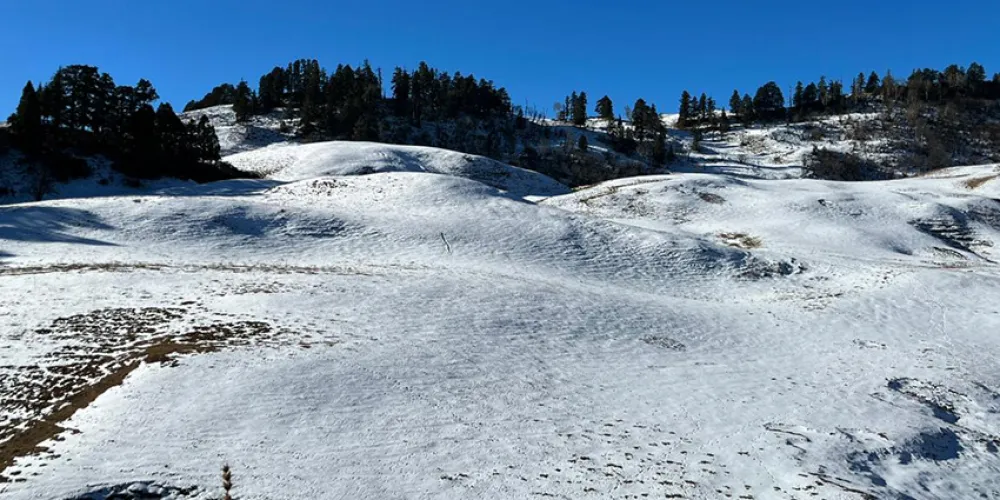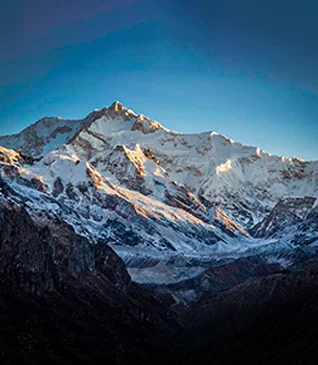As our planet undergoes unprecedented changes, one of the most profound impacts is the alteration of climate patterns due to global warming. Human-induced activities, primarily the release of greenhouse gases into the atmosphere, have led to a discernible rise in Earth's average temperature. This rise, in turn, triggers a cascade of effects that permeate through various aspects of our climate.
When it comes to the Himalayan region, a recent pattern has been observed as an effect of global warming and it is the change in precipitation pattern. Delayed and minimal snowfall in the Himalayan region is the direct effect of global warming. Where the mountains were covered with snow by the end of December are beginning to remain snow fry until January and this is something we should be worried about. Trekkers are waiting to see snow on the trails but there has been a serious dearth of snowfall.
Significance of Snowfall for Local Communities & Ecosystems

Snowfall isn’t something that simply adds beauty to the mountain landscapes but also a very essential component of nature that plays a pivotal role in supporting local ecosystems. Here’s how snowfall is crucial to mountain communities.
Water Source and Storage
Snowfall serves as a natural reservoir, storing water in the form of snowpack. The gradual melting of snow during warmer months replenishes rivers and streams, providing a vital water source for both flora and fauna.
Supports Biodiversity
Many plant and animal species in snow-covered regions are adapted to the seasonal cycle of snowfall. Snow cover acts as an insulator, protecting hibernating animals and providing habitat for a diverse range of organisms.
Required for Soil Moisture and Nutrient Cycle
Snowmelt contributes to soil moisture, facilitating nutrient cycling and supporting the growth of vegetation. Snowmelt contributes to soil moisture, facilitating nutrient cycling and supporting the growth of vegetation.
Impact of Delayed Snowfall on Tourism and Winter Sports

Impact on the Tourism Industry
Snowfall transforms landscapes into enchanting winter wonderlands, attracting tourists seeking snowy adventures. Delayed or erratic snowfall jeopardizes the appeal of these destinations, impacting local economies dependent on tourism revenue.
Impact on the Winter Sports Industry
Regions with reliable snowfall are often hubs for winter sports such as skiing, snowboarding, and snowshoeing. A lack of consistent snow cover diminishes the viability of these activities, leading to economic challenges for businesses in the winter sports industry.
Impact on the Livelihoods of Communities
Many communities in snow-covered regions rely on winter tourism as a significant source of income. Delayed snowfall disrupts the regular flow of tourists, affecting the livelihoods of local businesses, guides, and hospitality services.
Refreshing Snowfall Adorns Kedarkantha, Dayara Bugyal, and Brahmatal
As we grapple with the repercussions of rising temperatures, I also have some good news, we have recently received fresh snowfall in Dayara Bugyal, Kedarkantha and Brahmatal Trek.
Snowfall at Kedarkantha

Kedarkantha just received a fresh coat of snow and the beautiful forests of Pine and Oak are adorned with a fresh layer of powdery snow, creating a surreal contrast of greenery against the immaculate white landscape. The trekkers are in for a breathtaking vista.
Snowfall at Dayara Bugyal

The vast meadows of Dayara Bugyal have undergone a magical transformation into expansive snowfields with fresh snowfall. Oak groves, usually characterized by their golden hues, are now draped in a delicate layer of snow, creating a dreamlike atmosphere as sunlight filters through the snowy branches.
Snowfall at Brahmatal

Brahmatal Lake, nestled amidst snow-capped peaks, has become a serene canvas as snowflakes gently settle on its frozen surface, creating an almost otherworldly stillness. The undulating ridge lines of Brahmatal, with their sweeping views, now showcase an intricate pattern of snow drifts, inviting trekkers to trace their way through the ethereal landscape.
Do your bit for environmental conservation

A little initiative on our part can go a long way in preserving the mountains that are nothing but the planet’s treasures. By adopting some mindful practices, we can collectively reduce the impact of global warming on the landscapes we cherish. Here are some ways we encourage trekkers to do their bit.
→ Dispose of waste in designated receptacles and follow the principle of "leave no trace" to ensure the environment remains undisturbed.
→ Campfires contribute to deforestation and release carbon dioxide. Use a camp stove for cooking instead.
→ Use water sparingly, especially in arid regions. Carry a water purifier to minimize the need for single-use plastic bottles and reduce waste.
→ Avoid single-use items and prioritize durable, long-lasting gear to reduce waste.
→ Stay informed about the specific environmental challenges facing the trekking destination. Educate fellow trekkers about responsible practices and the importance of preserving the environment.
→ Consider participating in carbon offset programs to counterbalance the emissions associated with travel to and from the trekking destination.
→ Engage with local communities and conservation organizations to understand their efforts and contribute to ongoing initiatives. You can join our ‘Heal Himala’ initiative to contribute towards environmental conservation.
As we celebrate the pristine beauty brought by fresh snowfall on the trails of Kedarkantha, Dayara Bugyal, and Brahmatal, we are reminded of nature's ability to captivate and inspire. Embrace the magic of winter and venture into your favourite winter trail, make memories that will last a lifetime!





.webp)










.webp)


